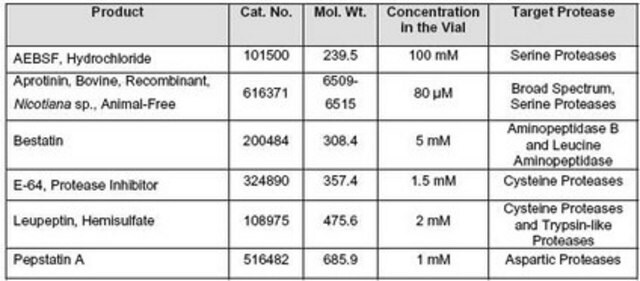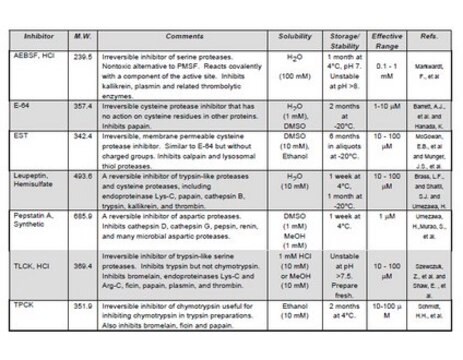539137
Protease Inhibitor Cocktail V
EDTA-Free, lyophilized, A cocktail of four protease inhibitors for the inhibition of serine, cysteine, but not metalloproteases.
Sinonimo/i:
EDTA free Protease inhibitor
About This Item
Prodotti consigliati
Nome del prodotto
Protease Inhibitor Cocktail Set V, EDTA-Free, A cocktail of four protease inhibitors for the inhibition of serine, cysteine, but not metalloproteases.
Livello qualitativo
Stato
lyophilized
Produttore/marchio commerciale
Calbiochem®
Condizioni di stoccaggio
OK to freeze
desiccated (hygroscopic)
Condizioni di spedizione
wet ice
Temperatura di conservazione
−20°C
Descrizione generale
Specificità
Azioni biochim/fisiol
Serine and cysteine proteases, but not metalloproteases
Attenzione
Ricostituzione
Note legali
Avvertenze
Danger
Indicazioni di pericolo
Classi di pericolo
Eye Dam. 1 - Skin Corr. 1A
Codice della classe di stoccaggio
8A - Combustible corrosive hazardous materials
Classe di pericolosità dell'acqua (WGK)
WGK 3
Certificati d'analisi (COA)
Cerca il Certificati d'analisi (COA) digitando il numero di lotto/batch corrispondente. I numeri di lotto o di batch sono stampati sull'etichetta dei prodotti dopo la parola ‘Lotto’ o ‘Batch’.
Possiedi già questo prodotto?
I documenti relativi ai prodotti acquistati recentemente sono disponibili nell’Archivio dei documenti.
I clienti hanno visto anche
Il team dei nostri ricercatori vanta grande esperienza in tutte le aree della ricerca quali Life Science, scienza dei materiali, sintesi chimica, cromatografia, discipline analitiche, ecc..
Contatta l'Assistenza Tecnica.
















